LRTA 1200 class
The LRTA 1200 class is the third-generation class of high-floor light rail vehicles (LRV) of the LRT Line 1.
Purchased as part of the second phase of the capacity expansion of the line, the trains entered service in December 2006
| LRTA 1200 class | |
|---|---|
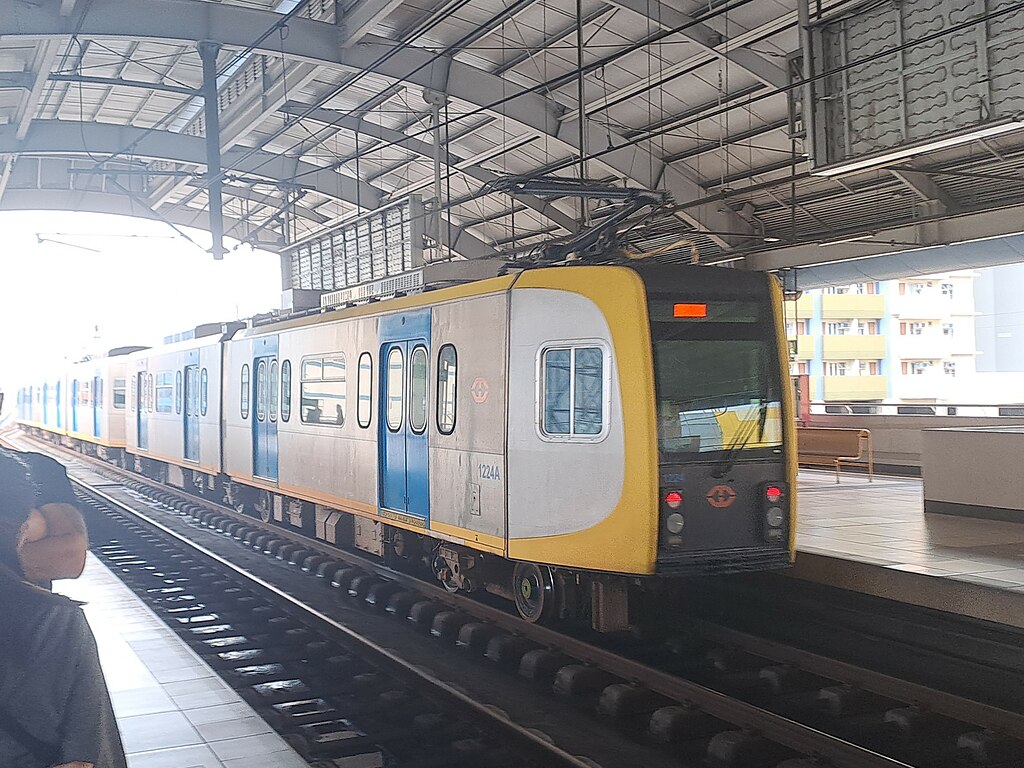
A Kinki Sharyo-built 1200 class train at FPJ station in August 2023
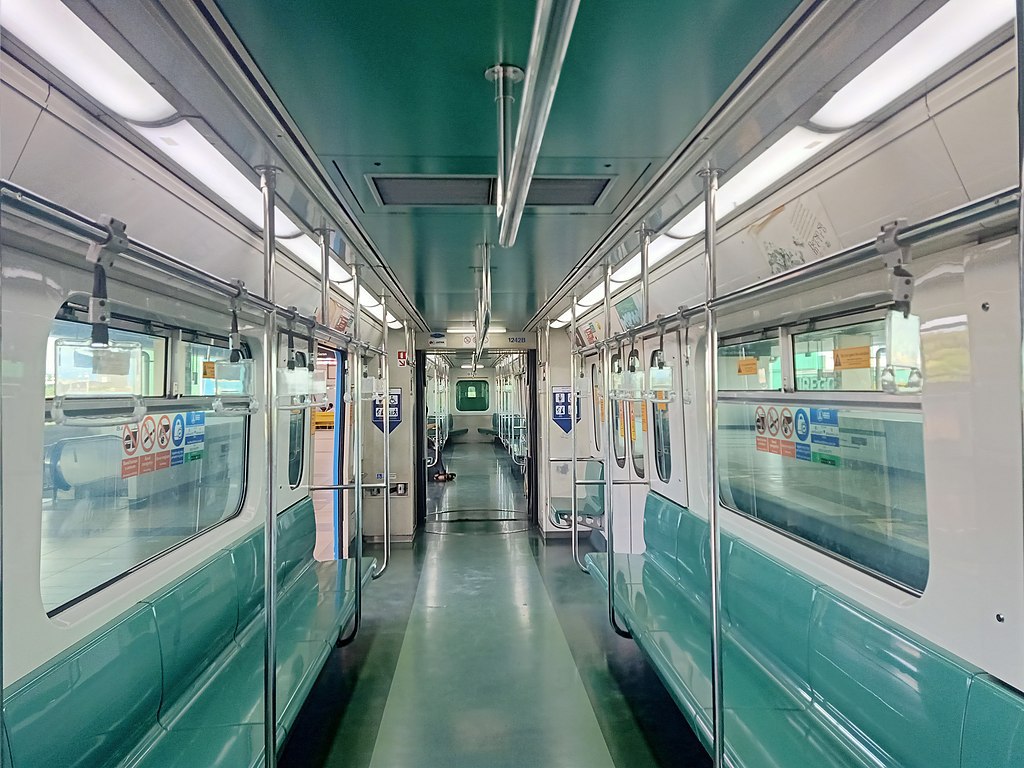
Interior of the train captured in February 2022. This LRV was built by Nippon Sharyo
|
|
| Stick type | Light rail vehicle |
| In service | 2006-present |
| Manufacturer |
Kinki Sharyo
Nippon Sharyo |
| Assembled at |
Osaka, Japan[note 1]
Toyokawa, Aichi, Japan[note 2] |
| Constructed | 2005–2006 |
| Entered service | December 11, 2006 |
| Number built | 48 vehicles (12 sets) |
| Number in service | 44 vehicles (11 sets) |
| Formation | 4 cars per trainset (Mc–M–M–Mc) |
| Fleet numbers | 1201-1248 |
| Capacity | 1,388 passengers |
| Operator(s) |
|
| Depot(s) | Baclaran |
| Line(s) served | LRT Line 1 |
| Specifications | |
| Car body construction | Stainless steel |
| Train length | 105.7 m[note 3] |
| Car length |
Driving cars: 26.35 m
Intermediate cars: 26.5 m |
| Width | 2.59 m |
| Height | 3.91 m |
| Floor height | 920 mm |
| Platform height | 690 mm |
| Entry | Step |
| Doors | 4 sets of 1.5 m × 1.9 m double-leaf pocket doors per side |
| Articulated sections | 2 per PRV |
| Wheel diameter |
New: 660 mm
Worn: 600 mm |
| Wheelbase |
Per bogie: 1.9 m
Bogie centers: 10 m Total: 20 m |
| Maximum speed | 60 km/h |
| Weight |
Driving car: 37.4 t
Intermediate car: 36.5 t |
| Axie load | 10.3 t |
| Steep gradient | 4% |
| Traction system | Mitsubishi Electric IGBT–VVVF |
| Traction motors | 4 × 105 kW 3-phase AC induction motor |
| Power output |
Per LRV: 420 kW
4-car trainset: 1.68 MW |
| Transmission | Two-stage reduction drive |
| Acceleration | 1.1 m/s² |
| Deceleration | 1.3 m/s² |
| Auxiliaries |
440 V AC IGBT static inverter
110 V DC batteries |
| HVAC | Roof-mounted duct-type air conditioning (2 units per LRV) |
| Electric system(s) | 750 V DC overhead wire |
| Current collector(s) | Single-arm pantograph |
| UIC classification | Bo′+2′+Bo′ |
| Wheels driven | 8 out of 12 per LRV |
| Bogies | Inside-frame type |
| Minimum turning radius | 25 m |
| Breaking system(s) | Knorr-Bremse regenerative and electro-pneumatic |
| Safety system(s) |
Siemens Mobility ATP (2007–2022)
Alstom Atlas 100 ATP (2022–present) |
| Coupling system(s) | Semi-permanent |
| Multiple working | Within type |
| Seating | Longitudinal |
| Track gauge |
1,435 mm
Standard track gauge |
Purchased as part of the second phase of the capacity expansion of the line, the trains entered service in December 2006
Background and purchase
With the completion of the initial capacity expansion of the LRT Line 1, its capacity was raised by half with the introduction of seven four-car trains and the upgrading of the existing two-car trains to three cars in 1999. However, its capacity was expected to become insufficient once the railway network in Metro Manila was completed in 2004 with the full opening of the LRT Line 2.On April 7, 2000, the Japan Bank for International Cooperation (JBIC) extended a ₱8.893 billion loan to finance the second phase of the capacity expansion project. While existing rolling stock were refurbished, twelve more four-car trains were purchased, in conjunction with other upgrades in signaling, telecommunications, and existing railway tracks as well as upgrades at stations and the depot.
Two firms bidded for the project: Kanematsu and Kawasaki Steel Corporation, and the joint venture of Sumitomo Corporation and Itochu. Marubeni was disqualified from the bidding but questioned the technicalities of the bidding procedure. However, delays were encountered in the bidding process, with senator Francisco Tatad claiming on March 21, 2004, that "unconfirmed reports" reaching him disclosed that groups identifying themselves with the President of the Philippines attempted to extort US$1 million from each bidder supposedly as campaign funds for the May 2004 elections. This, according to Tatad, limited the bidders to the two aforementioned firms. His claims were denied by LRTA administrator Pacifico Fajardo, as well as the Department of Transportation. Fajardo later claimed that JBIC posed "no objection" to the bidding, and said that it was conducted with transparency.
After a delay of more than three years since 2001, Sumitomo and Itochu won the contract and was given the go-ahead in March 2005. Following this, they signed a construction contract with Kinki Sharyo and Nippon Sharyo to manufacture the light rail vehicles.
Production and commissioning
In December 2005, officials from the Light Rail Transit Authority and Manila Tren Consortium—the project consultant of the capacity expansion project, inspected the full-scale mock-up model at Kinki Sharyo's factory in Osaka. It was then displayed at the line's depot in Baclaran in March 2006.After delivery in the third quarter of 2006, the third-generation trains underwent mainline test runs in the late evening, during non-operating hours. Some scheduled tests in late September 2006 were cancelled due to Typhoon Xangsane.
On December 9, 2006, at a ceremony in Baclaran, Japanese Prime Minister Shinzo Abe and President Gloria Macapagal Arroyo inaugurated the third-generation 1200 class trains. These were then deployed for revenue operations two days later. The trains raised the line's capacity from 27,000 passengers per hour per direction to 40,000 passengers per hour per direction.
Themed trains
On September 6, 2018, a 3G trainset was decorated with a special Gabay Guro decoration to celebrate the National Teachers' Month in the Philippines. The decoration has a library-themed look with images of books. The special themed train was launched on that date and ended a year later.
A scale model drawing of the LRTA 1200 class in a 4-car formation
Like the 1100 class, the 1200 class shares the 6-axle rigid body LRV design consisting of two articulated cars.
Car body
The car body has a length of 26 meters without couplers, a width of 2.59 meters, and a height of 3.91 meters. 1200 class LRVs have 4 electronic sliding doors on both sides. The train car body is made of beadless lightweight stainless steel, with composite materials on the indoor panels and aluminum on the inner bone to reduce weight. 1200 class LRVs have 4 electronic sliding doors on both sides.Each light rail vehicle has two roof-mounted air-conditioning units that has a cooling capacity of 41,000 kilocalories. In total, there are eight air-conditioning units in a four-car train set.
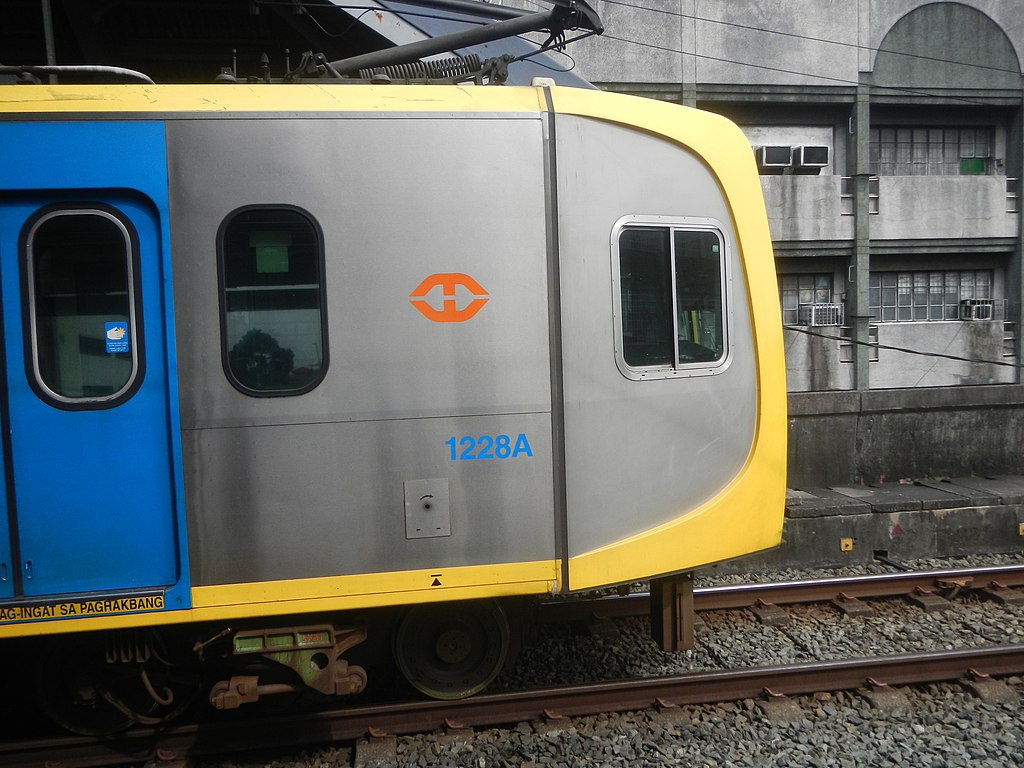
A 1200 class train (end cab) at 5th Avenue station in October 2016.
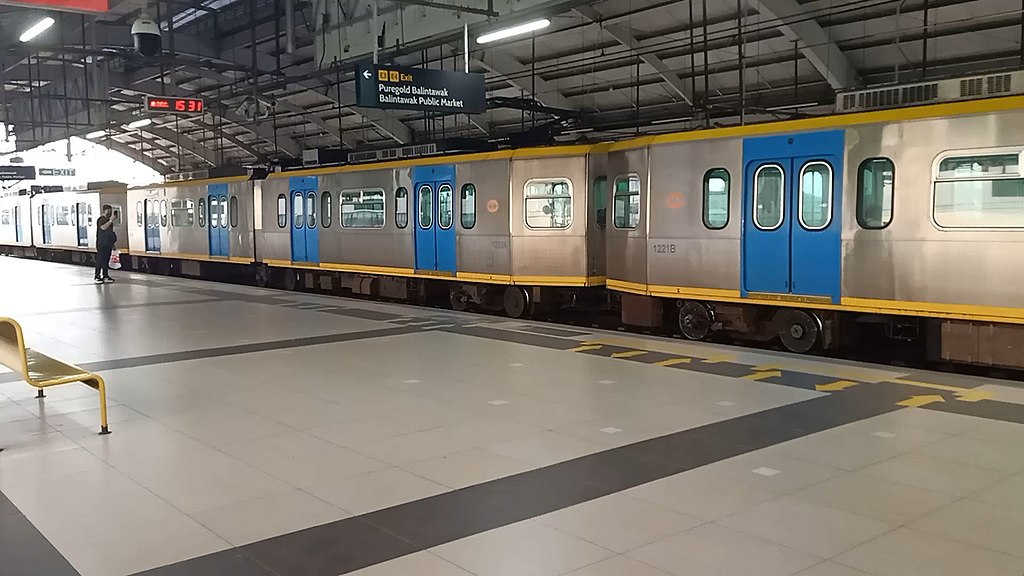
A 1200 class train at Balintawak station in December 2021.

A 1200 class train with wrap advertising at Vito Cruz in August 2023.
Interior
The interior is color-toned based on light and dark two-color green in the seats to complement the landscape of Manila. Seats are made of fiber reinforced plastic and has an aluminum bracket type cantilever longitudinal seat for reducing weight. Seating and grip sticks are designed to have ergonomic dimensions, aside from equipment arrangement inside the cab. A wheelchair-compatible space is provided beside the gangway of the intermediate car, alongside an equipped fire extinguisher.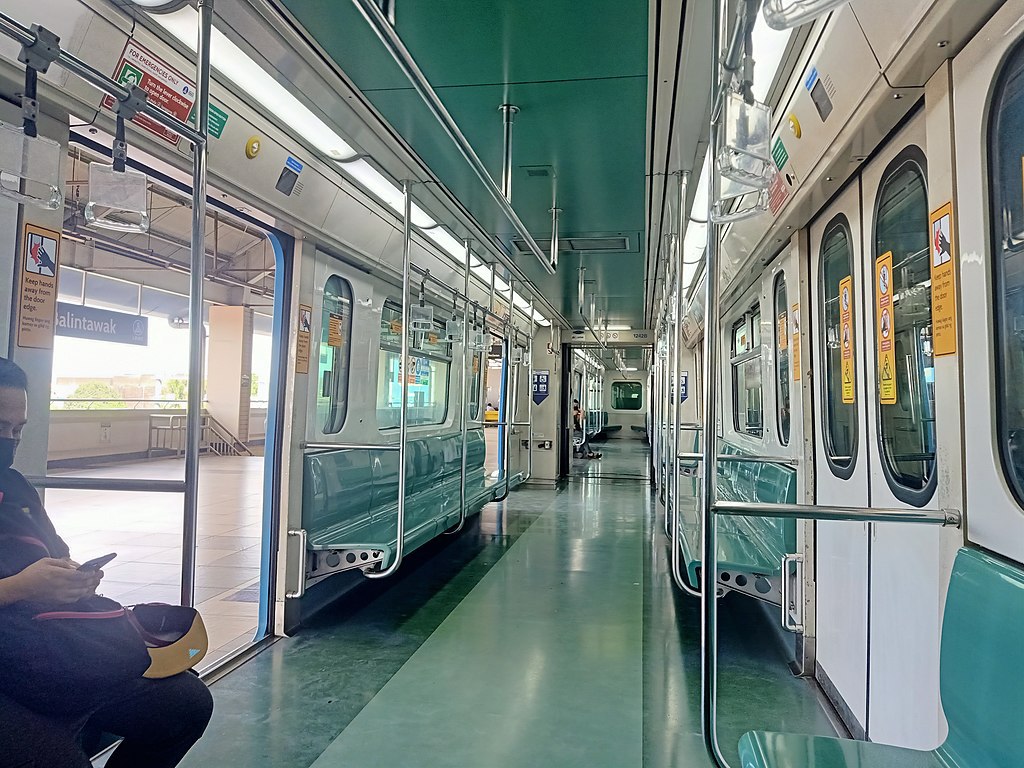
1200 class interior with new door stickers
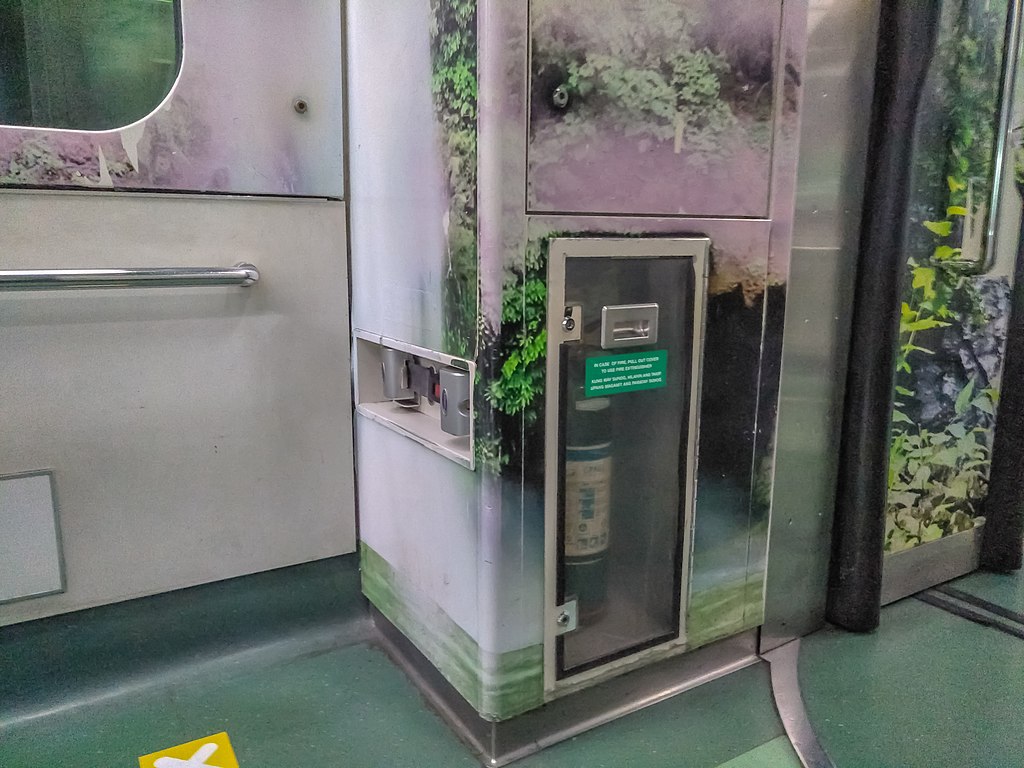
Wheelchair strap and space, and fire extinguisher
Electrical
Each LRV consists of four totally enclosed, self-ventilated 3-phase AC induction motors, driven by variable-voltage/variable-frequency drive (VVVF) inverters. Auxiliary power is sourced from 440-volt alternating current static inverters and 110-volt direct current batteries.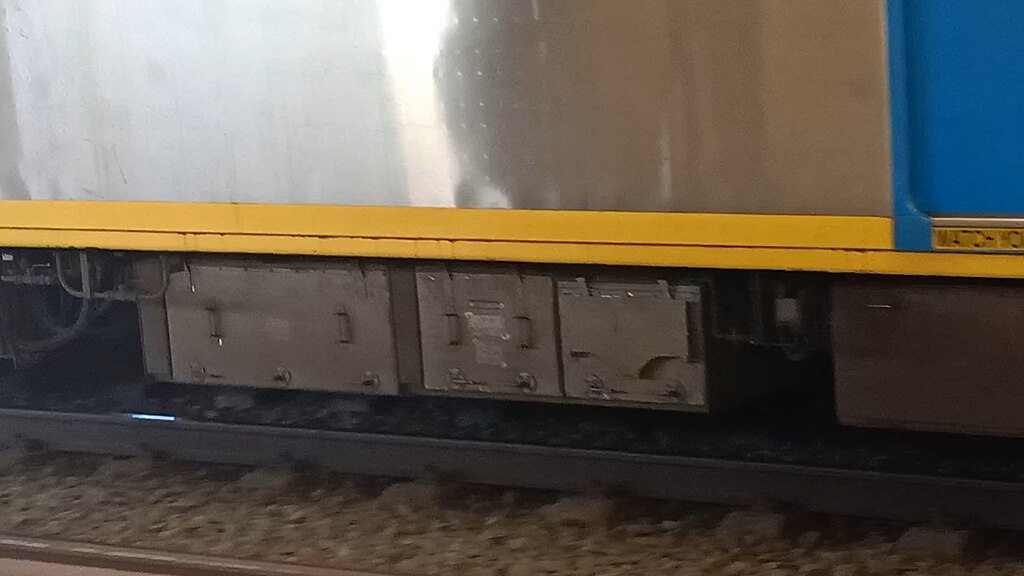
Mitsubishi Electric VVVF inverter of a 1200 class LRV.
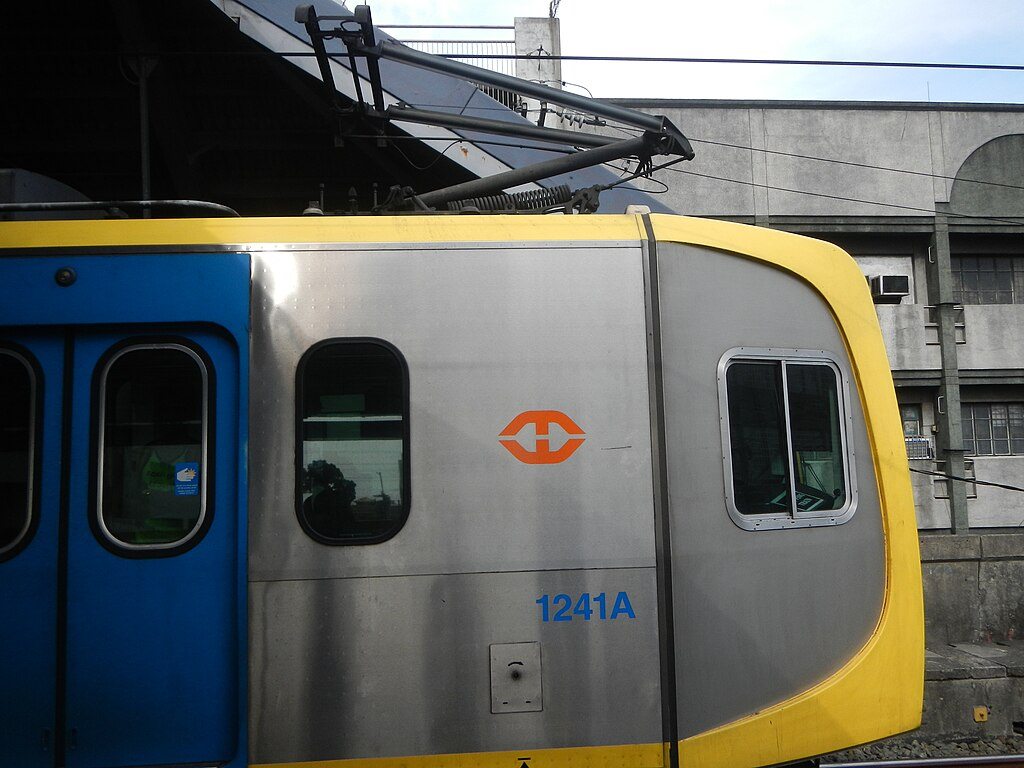
A single-arm pantograph above the driving car of the 1200 class
Mechanical and braking
Each LRV has three inside-frame bogies, similar to the 1000 class. The bogies consist of two motorized bogies at the ends of the LRV and one shared trailer bogie under the articulation. The primary suspension is a chevron rubber spring, while the secondary suspension is an air suspension, similar to the 1100 class. Semi-permanent couplers are present in the ends of each light rail vehicle except the driving cab section of the MC car.The 1200 class employs a regenerative and electronically controlled pneumatic braking system manufactured by Knorr-Bremse. The resistors are mounted on the roof for backup regenerative brakes. Each VVVF controller is equipped with an Electronic Command Braking Device (ECBD). Disc brakes are present on the bogies.
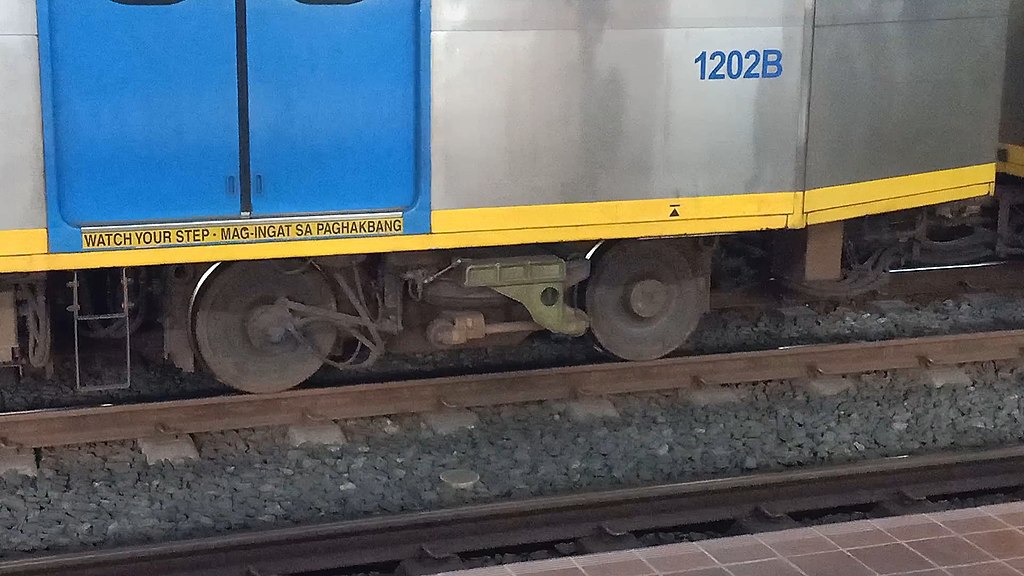
The inside-frame bogie of a 1200 class LRV
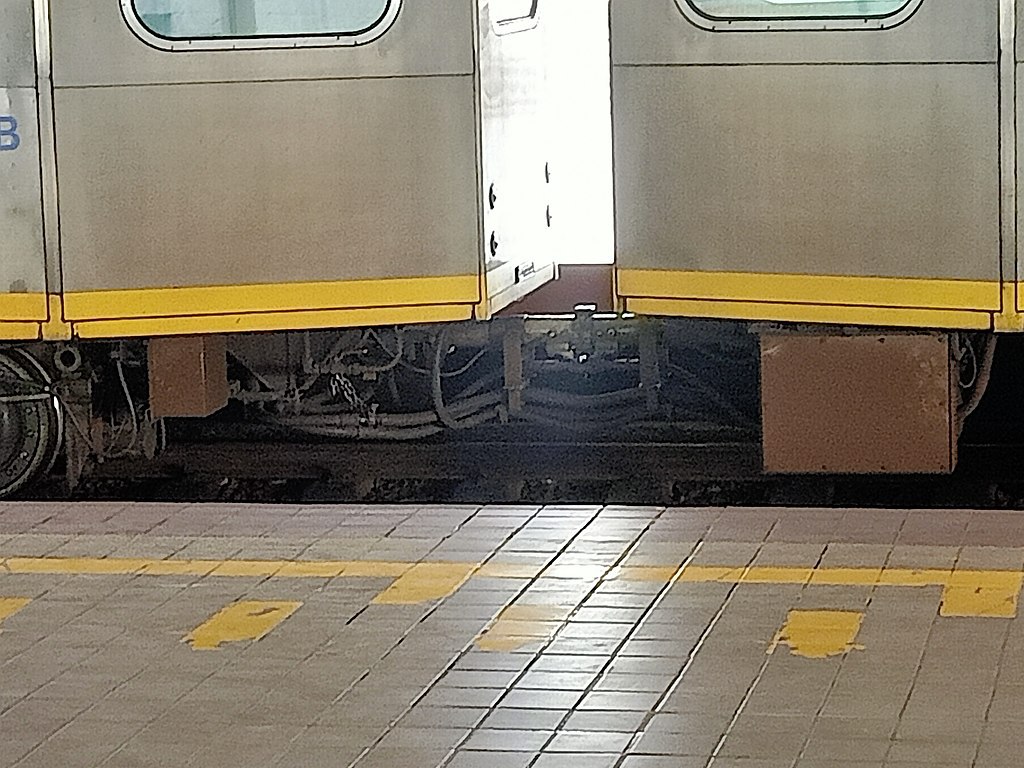
Semi-permanent couplers of the 1200 class
The configuration of a four-car trainset is Mc–M–M–Mc. Mc denotes a driving car while M denotes an intermediate car.
| Car type | Mc | M | |||
|---|---|---|---|---|---|
| A | B | A | B | ||
| Quantity | 2 | 2 | |||
| Control cab | Yes | No | No | No | |
| VVVF inverter | Yes | Yes | Yes | Yes | |
| Auxiliary inverter | Yes | Yes | Yes | Yes | |
| Pantograph | Yes | No | Yes | No | |
| Car length | 26.35 m | 26.5 m | |||
| Capacity | Seated | 66 | 70 | ||
| Standing | 272 | 286 | |||
| Total | 338 | 356 | |||
Legend
| Either out of service, scrapped, or decommissioned |
| Set No. | 1 | 2 | 3 | 4 | Manufacturer | Notes |
|---|---|---|---|---|---|---|
| 1 | 1201 | 1202 | 1203 | 1204 | Kinki Sharyo | — |
| 2 | 1205 | 1206 | 1207 | 1208 | ||
| 3 | 1209 | 1210 | 1211 | 1212 | Nippon Sharyo | |
| 4 | 1213 | 1214 | 1215 | 1216 | ||
| 5 | 1217 | 1218 | 1219 | 1220 | Kinki Sharyo | |
| 6 | 1221 | 1222 | 1223 | 1224 | ||
| 7 | 1225 | 1226 | 1227 | 1228 | Nippon Sharyo | |
| 8 | 1229 | 1230 | 1231 | 1232 | ||
| 9 | 1233 | 1234 | 1235 | 1236 | Kinki Sharyo | 1233–1234 re-configured to 1246–1245 |
| 10 | 1237 | 1238 | 1239 | 1240 | — | |
| 11 | 1241 | 1242 | 1243 | 1244 | Nippon Sharyo | |
| 12 | 1245 | 1246 | 1247 | 1248 | 1246–1245 re-configured to 1233–1234 |
- On June 24, 2010, two trains (1000 and 1200 class) collided at Balintawak station. As a result, LRVs 1248 and 1247 sustained damage. There were plans to restore it, but the involved cars remain idle as of 2022.
- On February 18, 2011, two trains (1000 and 1200 class) collided near Roosevelt Station in Quezon City at the reversing tracks, around a kilometer away to the east. There were no passengers on board when the incident happened. This caused the Roosevelt and Balintawak stations to remain closed for two months until the stations were reopened on April 11, 2011. An investigation was conducted and was shown that one of the drivers was texting when the incident occurred. This however caused LRV 1236, the 3rd generation unit involved in the incident, to be in idle state and has not yet been restored for service.
- On May 23, 2015, thousands of passengers were stranded after two trains (1000 and 1200 class collided near the Monumento station. A train driver was hurt after the impact caused his head to slam into the dashboard of the train. The accident, later revealed to be caused by power fluctuation that affected the signalling system, forced passengers to alight from the station until services was restored around 1 pm at the same day.